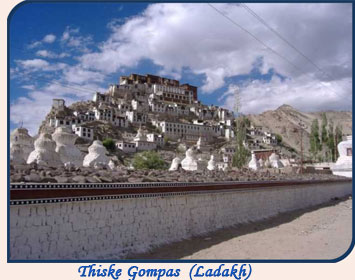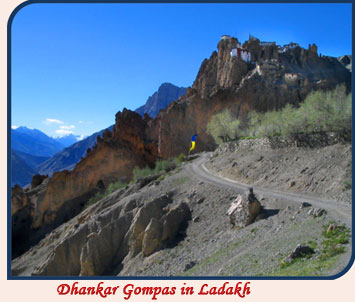Gompas in Ladakh...  Gompas are Buddhist temples, located in Tibet, Ladakh (India), Nepal, and Bhutan. Their design and interior details vary from region to region, however, all follow a general layout of a central prayer hall containing a Buddha statue, benches for the monks or nuns to engage in prayer or meditation and attached living accommodation. The gompa may also be accompanied by any number of stupas.
Ladakh is basically a high altitude desert and is one of the most remote regions of the state of Jammu and Kashmir. There are more than 100 Gompas or monasteries in Ladakh. These Gompas are religious residences of Buddhist monks who stay here and adhere to the Buddhist way of life, meditate and pray.
Gompas are Buddhist temples, located in Tibet, Ladakh (India), Nepal, and Bhutan. Their design and interior details vary from region to region, however, all follow a general layout of a central prayer hall containing a Buddha statue, benches for the monks or nuns to engage in prayer or meditation and attached living accommodation. The gompa may also be accompanied by any number of stupas.
Ladakh is basically a high altitude desert and is one of the most remote regions of the state of Jammu and Kashmir. There are more than 100 Gompas or monasteries in Ladakh. These Gompas are religious residences of Buddhist monks who stay here and adhere to the Buddhist way of life, meditate and pray.

Most of these Gompas are situated in remote areas, usually at great heights. Either the Mahayana or the Hinayana Buddhist sects built most monasteries in the Ladakh area of Kashmir. Monasteries in Ladakh are perched on high cliffs. The predominantly practiced religion in Ladakh is the Mahayana Buddhism. Mahayana Buddhism is based on the eighth tenet of the concept of the eightfold part as propagated by Lord Buddha. This form of Buddhism stresses on meditation and concentration. One of the most innovative concepts introduced by the Mahayanists is that of the bodhisattvas. The largest monastery in Ladakh is the Hemis Gompa that is located at a distance of 45 kilometers from Leh, the capital of Ladakh. The Namgyal Tsemo Gompa, which was built in the year 1430, houses a three-storyed statue of Lord Buddha. The Sankar Gompa is also an important monastery. The Dalai Lama inaugurated the Shanti Stupa in the year 1995. The Likhir monastery was built in the 11th century. There are huge clay images of Lord Buddha in this Gompa along with utensils and manuscripts from the olden days. Another old monastery is the Cave Gompa located at Shergole. Shey Gompas... Shey palace was built in 1645 by Deldon Namgyal as a summer residence for the kings of Ladakh. It is the oldest palace in Ladakh and above the palace is an even older ruined fortress. From the palace one can get the views of the ranges in the south to the Thiksey gompa and in the west to the Zanskar mountain ranges. Hundreds of chortens of all shapes and sizes stand below the palace and gompa.  These chortens demonstrate the interest taken by the Ladakhi kings and queens who succeeded Shey's builder.
In 1655, in memory of his father, this same king built the two-storey Shey gompa adjacent to the palace. In this gompa he installed a two-storey high image of the seated Buddha. Presently, there are only two caretaker lamas in residence.
After entering the central courtyard located on the second storey of the gompa, a large seated Buddha is found in the room to one's right. The seated Buddha is 12 meters high and worked of copper sheets gilded with gold. This Buddha is the biggest metal statue in the region and was the largest Buddha statue of any type in Ladakh until Thiksey gompa installed a 15 meter tall Buddha made of clay in 1970. These chortens demonstrate the interest taken by the Ladakhi kings and queens who succeeded Shey's builder.
In 1655, in memory of his father, this same king built the two-storey Shey gompa adjacent to the palace. In this gompa he installed a two-storey high image of the seated Buddha. Presently, there are only two caretaker lamas in residence.
After entering the central courtyard located on the second storey of the gompa, a large seated Buddha is found in the room to one's right. The seated Buddha is 12 meters high and worked of copper sheets gilded with gold. This Buddha is the biggest metal statue in the region and was the largest Buddha statue of any type in Ladakh until Thiksey gompa installed a 15 meter tall Buddha made of clay in 1970.
The most important moment in the construction of the Buddha figure is when the eyes are painted on, for this is the moment when the statue can "see". For this reason, the artist or monk will paint in a Buddha's pupils over his shoulder, with his back to the idol, for none would dare to look the Buddha in the eye. More About Pilgrimage Destinations... |